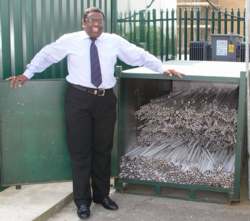Shedding light on waste management

The issue of recycling of fluorescent lams at the University of Hertfordshire has been solved by the university’s environmental engineer Dr Vall Rasaratnam by appointing Mercury Recyling to supply secure containers to store lamps until they are collected. The processes used by Mercury Recycling recycle or re-use 99.75% by weight of the lamp — including the mercury.
As a result of recent and forthcoming changes in legislation, sending discharge lamps to landfill will soon be a thing of the past. BRYAN NEILL discusses the implications of these changes and the emergence of recycling as the only feasible route for lamp disposal.It is well accepted that gas-discharge lamps such as fluorescent, sodium, metal-halide and mercury-vapour light sources represent a significant threat to the environment. All these lamps contain small amounts of mercury and, because of the vast numbers that are disposed of each year, could cause serious pollution.
Legislation For some years there has been a move away from sending these lamps to landfill, and this trend is now being strengthened by new and forthcoming legislation. Three pieces of legislation are driving this process. In July 2004 the new Landfill Directive reduced the total number of hazardous landfill sites in the UK from 250 to 10, with only a couple licensed to deal with waste containing mercury. For lamps and tubes, in particular, the cost of sending waste to landfill has trebled. On 16 July 2005, discharge lamps and tubes were classified as hazardous waste under the Hazardous Waste Regulations in England & Wales. Any site producing more than 200 kg (around 500 fluorescent tubes, for example) of any type of hazardous waste per annum has to register with the Environment Agency and obtain a site registration code. Waste contractors will not be allowed to collect waste from any site that has not registered. It is also important to note that this applies to all hazardous waste, such as CRT monitors and lead-acid batteries — so it does not take an organisation long to notch up its 200 kg quota. Another significant item of legislation is the WEEE Directive (Waste Electrical & Electronic Equipment) which, despite several delays, will come into force soon — at which time it will become mandatory to recycle discharge lamps and tubes.
Response The most cost-effective response to legislation will generally be to team up with a specialist contractor that is licensed to deal with hazardous waste such as lamps — this being the most challenging form of hazardous waste to deal with, mainly because lamps use so many different materials that have to be separated. Consequently, there are only a few specialist companies in the UK with the facilities and expertise to ensure that all lamp components are dealt with in compliance with the requirements of the legislation. For example, the vacuum in the lamps means they implode when crushed, so the crushing procedure has to be contained within specially constructed machines. Highly flammable hydrogen gas is also released when the sodium from sodium lamps is exposed to water, so special precautions have to be taken when processing and storing these lamps. In addition, the glass in many lamps is coated with a mixture of phosphors, which have to be stripped off before the glass can be re-used. These phosphors also contain mercury, which is distilled from the phosphor mix at very high temperatures (around 800°C) to reclaim pure liquid mercury. In the case of sodium lamps, the sodium is also reclaimed. Ferrous and non-ferrous metals are also separated from other components and sent for re-use. In preparation for these changes, a not-for-profit organisation called Sustainalite was established to, amongst other things, create an approved protocol for lamp recycling. SustainaLite has also developed a scheme accrediting both logistics and recycling companies that can meet the rigorous performance standards laid down under the scheme. These companies are continually monitored and listed in a central register so that building operators and their service providers can ensure compliance by opting for a SustainaLite accredited company.
Ongoing implications Lamp disposal is one element of the life-cycle costing that is being introduced by many organisations, which means that the cost of lamp disposal has to be taken into account from the initial design phase of a project. Lamp disposal costs now have a greater impact on the overall payback time of the project so that higher-quality, longer-life lamps will become viable for many more projects. Higher disposal costs may also encourage building operators to switch to group lamp-replacement schemes, rather than replacing individual lamps. A major incentive for group lamp replacement is that discharge lamps give out less light as they get older, while using the same amount of electricity. In fact, tests have shown that most discharge lamps start to waste energy when the light output has fallen below 80% of their original output. Figures provided by Sustainalite show that around 12.5 million lamps were recycled in 2004, but during the same period 100 million lamps were distributed in the UK — so there is still a huge gap. Changes in legislation will close that gap significantly in the coming years.
Bryan Neill is with Mercury Recycling Ltd, 17 Commerce Way, Trafford Park, Manchester M17 1HW.
Related links:








